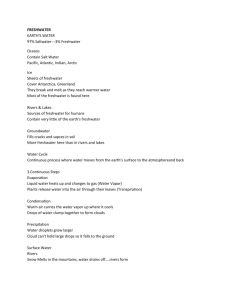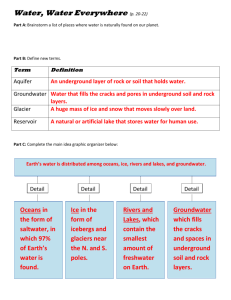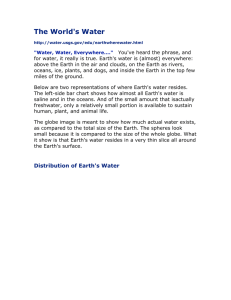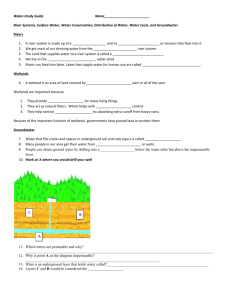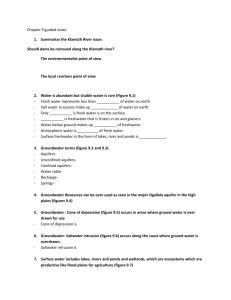Water Cycle - Marshall Community Schools
advertisement
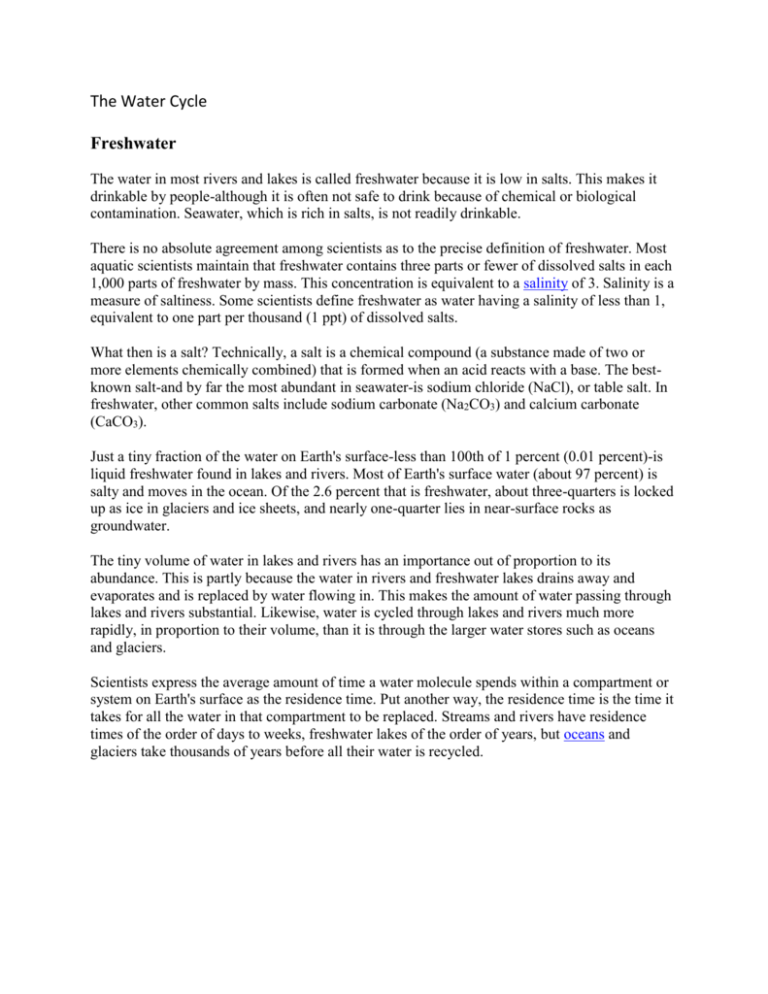
The Water Cycle Freshwater The water in most rivers and lakes is called freshwater because it is low in salts. This makes it drinkable by people-although it is often not safe to drink because of chemical or biological contamination. Seawater, which is rich in salts, is not readily drinkable. There is no absolute agreement among scientists as to the precise definition of freshwater. Most aquatic scientists maintain that freshwater contains three parts or fewer of dissolved salts in each 1,000 parts of freshwater by mass. This concentration is equivalent to a salinity of 3. Salinity is a measure of saltiness. Some scientists define freshwater as water having a salinity of less than 1, equivalent to one part per thousand (1 ppt) of dissolved salts. What then is a salt? Technically, a salt is a chemical compound (a substance made of two or more elements chemically combined) that is formed when an acid reacts with a base. The bestknown salt-and by far the most abundant in seawater-is sodium chloride (NaCl), or table salt. In freshwater, other common salts include sodium carbonate (Na2CO3) and calcium carbonate (CaCO3). Just a tiny fraction of the water on Earth's surface-less than 100th of 1 percent (0.01 percent)-is liquid freshwater found in lakes and rivers. Most of Earth's surface water (about 97 percent) is salty and moves in the ocean. Of the 2.6 percent that is freshwater, about three-quarters is locked up as ice in glaciers and ice sheets, and nearly one-quarter lies in near-surface rocks as groundwater. The tiny volume of water in lakes and rivers has an importance out of proportion to its abundance. This is partly because the water in rivers and freshwater lakes drains away and evaporates and is replaced by water flowing in. This makes the amount of water passing through lakes and rivers substantial. Likewise, water is cycled through lakes and rivers much more rapidly, in proportion to their volume, than it is through the larger water stores such as oceans and glaciers. Scientists express the average amount of time a water molecule spends within a compartment or system on Earth's surface as the residence time. Put another way, the residence time is the time it takes for all the water in that compartment to be replaced. Streams and rivers have residence times of the order of days to weeks, freshwater lakes of the order of years, but oceans and glaciers take thousands of years before all their water is recycled. The Percentage of Water in Different Compartments on Earth's Surface and the Residence Times in Each Compartment Oceans Ice caps and glaciers Groundwater (in rock) Soil moisture Freshwater lakes Saline (salty) lakes Atmosphere Rivers Plants and animals Percentage of Total 97.4 1.9 >0.6 0.01 0.008 0.006 0.001 0.0001 0.00004 Typical Residence Time Thousands of years Thousands of years Days to thousands of years Weeks Years Years to thousands of years 1-2 weeks 2 weeks 1 week The size of a system, and the pace at which water is recycled through it, affects the dilution of pollutants and their rate of removal. Because the amount of water in a river system is comparatively small, the impact of any pollution is likely to be great because the dilution effect is small. On the other hand, unless pollutants are trapped in sediments in and around the river system, pollutants may be flushed from the system fairly rapidly-although the freshwater community of organisms affected by the pollution may take many years to recover. The Hydrologic Cycle As described earlier, water is remarkable for many reasons, not least because it can exist as a gas, liquid, or solid across the range of temperatures commonly encountered on Earth's surface. Physical-state changes from liquid to gas (evaporation) and back from gas to liquid (condensation) are major factors driving the cycling of water between land, sea, and air. The Sun's heat (solar radiation) is the prime source of energy driving the water cycle. It causes water to evaporate from Earth's surface, and its heating effect stirs the oceans and the atmosphere, transporting water and its stored heat from one place to another. Warmed by solar radiation-especially infrared radiation, light with wavelengths slightly shorter than the visible spectrum of light-water evaporates from the sea surface and, from land surfaces and their associated lakes and rivers. Only pure water evaporates; minerals and other dissolved substances are left behind. The rate at which water evaporates depends upon temperature. Evaporation increases as temperature rises because by absorbing heat energy more molecules have the energy to break free of the water surface and enter the gaseous state. Evaporation also depends upon the relative humidity of the air. When the air is absolutely saturated with water, evaporation ceases. When the air is dry-other factors aside-evaporation is likely to be rapid. When water enters the air as a gas (water vapor), it often rises several hundred feet or more above the Earth's surface, where it cools. When the air becomes saturated with water-its relative humidity reaches 100 percent-water tends to condense around dust particles to form droplets or, in freezing conditions, ice crystals. The droplets or ice crystals become visible as clouds. As the droplets or crystals coalesce, they become large and heavy enough to drop out of the clouds as rain, or if frozen, as snow. Sometimes, powerful updrafts drive raindrops upward where they freeze before falling to Earth as hail (frozen rain). Clouds are readily pushed along by even light winds, so water that evaporates in one place can soon be carried hundreds of miles before falling back to Earth as precipitation. When precipitation hits the land, some evaporates almost immediately and returns to the air as water vapor. Some soaks into the soil, where it is absorbed by plant roots and drawn up the stem. Most of this water is later lost by evaporation from the plant's leaves, a process called transpiration. Of the water that remains on the land, some runs over the surface as surface runoff and gathers in streams, rivers, and lakes. Some sinks into the soil and stays there temporarily as the soil water store, and some penetrates to the rocks beneath to add to the temporary groundwater store. The balance between runoff, soil water, and groundwater formation varies depending on factors such as the type and amount of precipitation, the contours of the land, and the composition and layering of the soil and rock. Underlying rock such as chalk or other types of limestone is permeable to water (it allows water to pass through), and the water percolates readily into the ground. In the country, where limestone is the underlying rock, there may be relatively few ponds, lakes, and rivers above ground, although such features may occur in caves and fissures beneath the ground. Where the soil and rocks are impermeable clays, surface runoff may be greater, and streams, lakes, and marshes more common. The diagram depicts the routes of water flow into a stream. In the soil and in the rocks beneath the soil, water gathers and may saturate the ground up to a level-typically a few feet beneath the soil surface-known as the water table. The water table is not horizontal but follows approximately the contours of the land surface. The water table usually rises and falls with the changing seasons according to net effects of precipitation and evaporation. In most temperate regions, the water table is lower in summer and higher in winter. Water moves sideways within the water table because the soil or rock contains an interconnected series of spaces. Soil and material beneath it such as sand or gravel have numerous tiny spaces called pores between the constituent particles through which the water can flow. Underlying rock, such as chalk or sandstone, contains larger spaces and cracks through which water can percolate. Aquifers are highly permeable layers of rock through which groundwater seeps in sufficient amounts to supply wells. Aquifers are an important reserve of freshwater for people in regions where little surface water-in the form of lakes or rivers-is available. Water circulates between sea, air, and land. At any point in time, most of the water in the hydrologic cycle is held in storage in the oceans. Rivers play a role out of proportion to their size in carrying water from the land surface to the sea. They are rapid channels of water movement rather than stores. Lakes, on the other hand, are temporary stockpiles of water. About two-thirds of all liquid freshwater on Earth's surface is stored in about 250 large lakes. Objectives- Explain how water is distributed among fresh and salt water; explain how water moves through the water cycle; identify how people and other living things use water Questions 1. What is fresh water? 2. What percent of the surface water is fresh water? 3. How much of the surface fresh water is in the liquid state? 4. Give a possible reason why water residence time is lowest in rivers. 5. Does pollution have a large or small effect on a river system? Explain. Hydrologic cycle 6. What factor drives the water (hydrologic) cycle? 7. What provides the energy for the water cycle? 8. What 2 factors affect evaporation? 9. Describe what can happen to water vapor after it evaporates. 10. List what can happen to water after it falls as precipitation. 11. What factors determine if water on the surface becomes groundwater? 12. What is the water table? 13. What is an aquifer?
